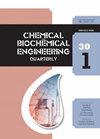管状陶瓷膜和平板超滤膜处理纺织废水的通量衰减研究
IF 0.9
4区 生物学
Q4 BIOTECHNOLOGY & APPLIED MICROBIOLOGY
引用次数: 1
摘要
本文对两种孔径相同但化学成分和配置模块不同的超滤膜在纺织废水处理中的应用进行了评价。基于平板聚醚砜(PES)和管状多通道陶瓷膜两种商用膜的溶质吸收率数据进行了表征,并在不同摩尔质量的聚乙二醇(PEG)溶液中提供了通量下降情况。对化学清洗后的渗透通量回收率进行了评价,并在分析纺织废水和渗透物的基础上对废水处理效率进行了评价。通过对渗透通量下降的研究表明,采用PES膜处理废水时,发生污染的可能性较小。事实证明,PES平板膜处理废水更有效,总有机碳(TOC)和去色效率分别为72%和85%。本文章由计算机程序翻译,如有差异,请以英文原文为准。
Flux Decline Study of Tubular Ceramic and Flat Sheet UF Membranes in Textile Wastewater Treatment
This work gives an assessment of the application of two ultrafiltration membrane types, which are the same in pore size but different in chemistry and configuration module, for textile wastewater treatment. Characterization was based on the solute rejection data of two commercial membranes, flat sheet polyethersulfone (PES) and tubular multichannel
ceramic membrane, and flux decline was provided using polyethylene glycol (PEG) solutions of different molar mass. The permeate flux recovery after chemical cleaning was evaluated, and the efficiency of wastewater treatment was estimated on the basis of the analysis of textile wastewater and permeate. The permeate flux decline study showed that fouling was less likely to occur when PES membrane was used for wastewater treatment. PES flat membrane has proven to be more effective in the treatment of wastewater with total organic carbon (TOC) and colour removal efficiency of 72 % and 85 % respectively.
求助全文
通过发布文献求助,成功后即可免费获取论文全文。
去求助
来源期刊
CiteScore
2.70
自引率
6.70%
发文量
23
审稿时长
>12 weeks
期刊介绍:
The journal provides an international forum for presentation of original papers, reviews and discussions on the latest developments in chemical and biochemical engineering. The scope of the journal is wide and no limitation except relevance to chemical and biochemical engineering is required.
The criteria for the acceptance of papers are originality, quality of work and clarity of style. All papers are subject to reviewing by at least two international experts (blind peer review).
The language of the journal is English. Final versions of the manuscripts are subject to metric (SI units and IUPAC recommendations) and English language reviewing.
Editor and Editorial board make the final decision about acceptance of a manuscript.
Page charges are excluded.

 求助内容:
求助内容: 应助结果提醒方式:
应助结果提醒方式:


